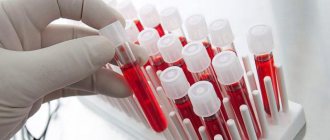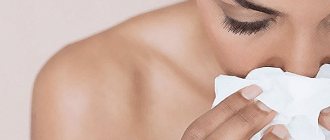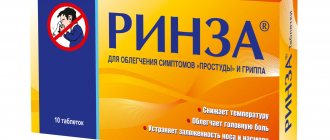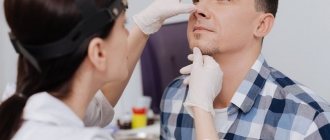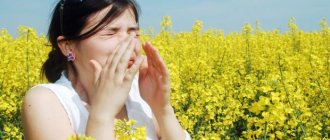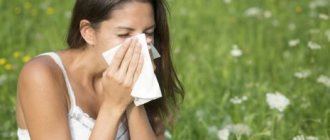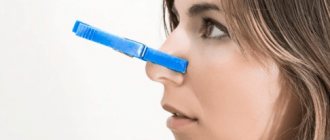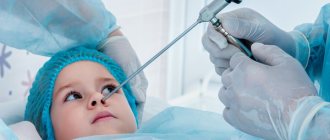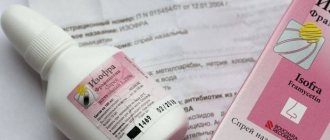Vasomotor rhinitis is an inflammatory process of the nasal mucosa. In a healthy state, the vessels are able to control the volume of air, changing their size due to filling with blood. When bacteria, viruses, microbes, allergens and other foreign bodies enter the body from the outside, the tissue of the shells increases and, as a result, the nasal cavity narrows. In addition, an edematous-secretory reaction is caused by an increase in the excitability of the peripheral parts of the autonomic nervous system (ANS).
Vasomotor rhinitis occurs in people of all ages. It affects more than 10% of residents of megacities. A third of patients experience severe signs of the disease at regular intervals. The average age of patients is 35-45 years. According to statistics, women are twice as likely as men to suffer from vasomotor rhinitis. Treatment should begin after diagnosis. Due to the fact that the disease develops slowly, there is usually no rush to eliminate its symptoms. As a result, it begins to progress and complications appear.
- Patient examination
- Drug therapy
Forms of the disease
Vasomotor rhinitis is of two types: allergic and neurovegetative.
Allergic rhinitis
Allergic rhinitis is a disruption in the blood circulation process that occurs under the influence of allergens, as well as other irritating factors.
The moment they enter the body, an allergic reaction begins, which can be specific or nonspecific. The specific reaction has three stages:
- immunological (production of antibodies),
- the emergence of mediators,
- pathophysiological (inflammatory process).
The symptoms of a nonspecific reaction are caused by close contact with the allergen.
The disease can manifest itself in a seasonal or year-round form. In the first case, the violation is short-term in nature and does not require a prompt response. In the second case, the patient needs to identify the type of allergen using tests. Treatment of vasomotor allergic rhinitis involves the use of antihistamines.
Neurovegetative rhinitis
Neurovegetative rhinitis is a disorder that occurs due to improper filling of the nasal cavity with blood.
It usually develops in people with ANS diseases or under the influence of such external factors:
- aggressive resins,
- dust,
- irritating odors.
Seasonality does not play a role in this case. The main symptom is a runny nose, which appears in the first half of the day and goes away in the evening. Symptoms and treatment of vasomotor rhinitis of the neurovegetative form are determined by an otolaryngologist and a neurologist.
Fleming's ointment
Ointment based on calendula, game hazel, aesculus. Effectively reduces the symptoms of inflammation and has a bactericidal effect.
The ointment heals the mucous membrane, improves blood supply and improves immunity.
The drug should be placed into the nasal passages with turunda and kept for up to ten minutes. Repeat three times a day for two weeks.
Complete disappearance of all symptoms of vasomotor rhinitis most often occurs after ten days of use.
No adverse reactions were observed.
The drug is approved for use by pregnant women.
Reviews:
Anna Sadovaya, 37 years old. “For some time I used Fleming’s ointment for hemorrhoids, and recently I learned about its effectiveness for the treatment of vasomotor rhinitis.
I tried it and it surprisingly worked.”
Stages of the disease
As vasomotor rhinitis progresses, it goes through three stages of development:
- First stage. Symptoms are not expressed; the nose becomes blocked when there is an unpleasant odor or when there is a change in temperature.
- Second stage. Inflammation of the mucous membrane begins, and the person is bothered by attacks of itching. Possible development of polyps.
- Third stage. The patient loses his sense of smell, nasal discharge begins, and there is a feeling of mucus in the throat. Immunity decreases.
At risk are people who live in places with high levels of climate humidity, who are predisposed to bad habits and exposure to allergens, as well as those who have unstable hormone levels in the body.
Vasomotor rhinitis: what is it?
The vessels located in the nasal mucosa lose their tone when exposed to certain factors, and the nasal passages narrow. For this reason, breathing becomes difficult and mucus appears, since the vessels in the nasopharynx do not absorb, but release its excess volume. The patient begins to suffer from a runny nose.
Moreover, the nasal canals lose another function - they stop filtering the inhaled air from allergens. The situation is complicated by the fact that there is a noticeable narrowing of the nasal canals, and little oxygen is supplied to the blood due to lack of air. Sneezing and sore throat are integral signs of the disease.
Vasomotor rhinitis is divided into 3 types:
- vasomotor: swelling is present, but there is no outflow of mucus;
- hypersecretory: a lot of mucus appears;
- combined: both swelling and mucus are noted.
ATTENTION! Often a person does not see a doctor to cure this disease, but tries to cope on his own. Due to inadequate therapy, chronic vasomotor rhinitis appears again and again, regularly going from remission.
Reasons for appearance
The reasons that contribute to an imbalance in the structure of the inferior turbinate can be physiological, psychological, environmental and pharmacological.
| External factors: | Internal factors: |
|
|
Symptoms of the disease can appear during age-related changes in the body (female, male menopause), bearing a child and breastfeeding. Regular use of medications can also lead to rhinitis:
- antidepressants,
- tranquilizers,
- alpha blockers,
- contraceptives,
- non-steroidal drugs.
In a child, rhinitis may be a consequence of teething. Also, the reason may lie in primary pathologies: tonsillitis, pharyngitis, deviated septum, etc.
Prevention
Preventive measures include:
- avoiding contact with irritants (allergens, alcohol, tobacco smoke, strong odors, etc.);
- special food;
- correction of abnormalities of the nasal structure (for example, deviated nasal septum);
- physical activity (jogging, hardening, walking in the fresh air);
- treatment of diseases of the gastrointestinal tract;
- avoiding the use of vasoconstrictor drugs;
- Immediately consult a doctor at the first symptoms of the disease.
If you suspect such rhinitis, you should contact a specialist.
Symptoms and signs
The main symptom of vasomotor rhinitis is persistent breathing difficulties. Nasal congestion occurs spontaneously. This usually happens in the morning and while lying down. Breathing disorders are accompanied by sneezing, lacrimation, and the release of clear mucus from the mouth. If the disease is accompanied by a bacterial infection, the discharge becomes yellow and green. Body temperature does not increase with vasomotor rhinitis.
The nose may also become stuffy when the patient changes climate or experiences excessive physical activity.
In addition, the clinical picture includes the following main symptoms:
- spasms in the temples,
- redness of the eyeballs,
- heaviness and swelling in the bridge of the nose,
- uncontrolled release of mucus and saliva,
- decreased quality of odor perception,
- redness of the nasal mucosa.
Among the secondary symptoms:
- decreased performance,
- feeling of weakness,
- unstable mental state,
- nervous disorders,
- loss of appetite,
- bitterness in the mouth,
- decreased immunity,
- dyspnea,
- excessive sweating.
Uncontrolled use of drops for vasomotor rhinitis can cause unexpected attacks of itching in the nose. Insufficient ventilation of the lungs entails a disruption of the blood flow process and, as a result, a deterioration in the body’s oxygen supply. This leads to functional disorders of the ANS.
Sinupret tablets
Plant-based medicine.
Includes:
- Gentian root;
- Primrose flowers;
- Sorrel grass;
- Elder flowers and others.
The components of the drug reduce inflammation and have a secretomotor effect, that is, they promote the discharge of discharge from the nose.
Therefore, sinupret is especially indicated for runny noses with viscous secretions.
Contraindications:
- Hypersensitivity to components;
- Age up to 6 years;
- Alcoholism.
Apply two tablets three times a day for 1-2 weeks. They do not need to be chewed.
Reviews:
Lyubov Koretskaya, 44 years old. “The diagnosis of vasomotor rhinitis was made two years ago.
For a long time I used only sprays, but now, on the advice of a doctor, I added tablets.
The effectiveness of treatment has increased significantly, nasal congestion and itching have disappeared.”
Diagnostics
Before starting treatment for vasomotor rhinitis, the disease should be diagnosed.
| The criteria that the doctor uses when interviewing: | Characteristic signs of the patient's condition: |
|
|
The doctor evaluates the medical history to determine the cause and history of rhinitis. At this stage, the presence of other diseases of the nasal cavity should be excluded.
Patient examination
Determining the clinical picture involves an objective examination of the patient. Before determining how to treat chronic vasomotor rhinitis, the otolaryngologist must determine whether:
- difficulty contracting the walls during breathing;
- an increase in the size of the walls of the nasal cavity;
- mucous or watery discharge;
- disturbance of a person’s well-being (weakness, fatigue).
If necessary, an allergist and neurologist are involved in making a diagnosis. At this stage, symptoms of VSD are revealed:
- lowering blood pressure,
- feeling of coldness in the extremities,
- joint and muscle pain,
- high sweating,
- anxious state.
After this, laboratory and clinical research methods are carried out.
Rhinoscopy
Rhinoscopy is an examination of the nasal cavity using auxiliary instruments: a funnel for children and a mirror for adults. In modern conditions, the procedure is carried out using a video camera. The result is displayed on the monitor, which makes it possible to analyze the disease over time.
During anterior rhinoscopy, a mirror is inserted into the hole to a depth of one to two centimeters, after which it opens in the anterior sections of the sinus. This allows you to evaluate the condition of the anterior part of the septum, as well as the overall nasal passage.
Average rhinoscopy involves inserting a speculum below the middle concha. The doctor can see the middle meatus.
During posterior rhinoscopy, the fiberscope is inserted through the oral cavity to the pharynx. This way you can assess the condition of the back of the shell. To prevent the gag reflex, treatment with an anesthetic occurs. Based on the results of rhinoscopy, it is determined how to treat vasomotor rhinitis without surgery.
Laboratory research methods
To know how to cure vasomotor rhinitis, you need to conduct laboratory diagnostics:
- A general and biochemical blood test allows you to see the number of eosinophils.
- Allergy tests:
- skin allergy tests - when the pathogen comes into contact with the skin, an allergic reaction occurs;
- assessment of immunoglobulin G to the pathogen involves a laboratory analysis of blood serum using a special tablet.
- An immunogram allows you to assess the quality of the immune system.
- Culture analysis of nasal discharge excludes the presence of an additional infection (rhinitis, sinusitis).
- An x-ray shows a change in the color of the maxillary sinuses and the presence of polyp formation.
The list of additional diagnostic methods includes an electrocardiogram and an electroencephalogram.
Causes of rhinitis
With vasomotor rhinitis, the causes are as follows:
- autonomic dysfunction,
- abuse of vasoconstrictor drops for a runny nose,
- increased estrogen levels,
- organic pathologies of the nasopharynx.
Chronic vasomotor rhinitis often accompanies autonomic dysfunction or vegetative-vascular dystonia. The main task of the autonomic nervous system is to normalize blood circulation, dilate and constrict blood vessels, that is, ensure the processes through which the normal functioning of the human body occurs.
With dysfunction of the autonomic nervous system, a violation of vascular tone is observed. The symptoms of this pathology are quite extensive, and vasomotor rhinitis is one of the signs of the disorder.
Vasomotor rhinitis can also be caused by long-term use of vasoconstrictor drops. It is important to remember that drugs in this group are used in short courses, no more than 5-7 days. Long-term use of drops leads to disruption of vascular tone, as a result, the effectiveness of the drugs is reduced and the symptoms intensify.
Alternative reasons
Long-term use of antihypertensive drugs and drugs that inhibit the activity of the nervous system has the same effect:
- antidepressants,
- sedatives,
- tranquilizers.
Increased levels of estrogen are observed in pathologies of the female reproductive system and during pregnancy. In the first case, consultation with an endocrinologist and gynecologist is necessary; in the second case, the runny nose is temporary, and the condition of the blood vessels returns to normal after childbirth.
Organic pathologies that disrupt vascular tone include various neoplasms in the nasopharynx (for example, polyps). Vasomotor rhinitis is often encountered by patients who have a deviated nasal septum.
Predisposing factors
Signs of a runny nose against the background of impaired vascular tone may appear under the influence of the following factors:
- climate change,
- chemical substances,
- stress,
- pathologies of the bronchi and lungs.
In these cases, rhinitis is often temporary. Nasal breathing improves after eliminating the provoking factor.
Exposure to irritants, such as chemicals, cigarette smoke, or perfumes, can trigger vasomotor allergic rhinitis.
Treatment
Treatment of both initial and chronic forms of vasomotor rhinitis is not an easy process.
Complex therapy includes:
- taking measures to protect against infection,
- normalization of lifestyle and recreation,
- correction of diet,
- rejection of bad habits,
- drug treatment,
- physiotherapeutic procedures,
- surgical intervention.
The set of measures depends on the form of the disease, the age of the patient, as well as the presence of other disorders in the body. Treatment of vasomotor rhinitis is carried out at home or in a hospital.
Drug therapy
The goal of drug therapy is to eliminate the symptoms of the disease with further relief of the patient’s condition. To do this, the otolaryngologist may prescribe:
- Antihistamines 2 and 3 generations. They eliminate signs of allergies and fight viral pathogens.
- Medicines that constrict blood vessels. Thanks to the reduced size of the vessels, free breathing is restored.
- Preparations based on corticosteroid hormones. They eliminate the inflammatory process and improve the functioning of the immune system.
Additionally, M-cholinergic receptor blockers and cell membrane stabilizers are prescribed. We recommend asking your doctor what drops you can use for vasomotor rhinitis.
Be sure to rinse the nasal cavity with a solution of sea salt. Make sure that the solution temperature is between 35-40 °C. It is better to prepare it before direct use. The procedure is carried out daily for 10 days.
Vasomotor rhinitis can be treated at home. Its duration is determined individually. The doctor determines it based on the characteristics of the disease.
Drugs for vasomotor rhinitis
Treatment of vasomotor rhinitis with drugs gives stable and long-lasting results. Medicines such as Sialor Rhino and Sialor Aqua are very popular due to their undeniable advantages over other medications.
"Sialor Rhino"
"Sialor Rhino" are nasal drops that have a vasoconstrictor effect. Indications for their use:
- vasomotor rhinitis,
- acute respiratory diseases,
- restoration of drainage function during inflammation.
The drug is prescribed to children and adults.
Among the advantages of the drug "Sialor Rhino":
- convenient way to use,
- instant effect (within a few minutes),
- Possibility of twice daily use,
- the presence of three dosage variations,
- no risk of cross-contamination (contamination during production),
- hermetic packaging (polymer containers).
The basis of Sialor Rhino is oxymetazoline, an alpha-adrenergic stimulant for local use. The product reduces the degree of swelling of the sinus mucosa, clears the airways, and also alleviates the patient’s condition. Its action begins after five minutes and lasts up to 12 hours.
"Sialor Aqua"
"Sialor Aqua" is an isotonic solution for intranasal use. It is based on purified sea water, which not only helps maintain nasal hygiene, but also fights the signs of vasomotor allergic rhinitis.
Among the features of “Sialor Aqua”:
- salt composition,
- safe effect on the body,
- can be used at any age (even for children under one year old),
- convenient and economical form of release (plastic ampoules).
The drug maintains the normal microflora of the mucous membrane, promotes the saturation of mucus with goblet cells, and has an anti-inflammatory and antibacterial effect. Regular use of the solution allows you to stabilize regenerative processes, and also increases the level of activity of the epithelium to external stimuli.
Medicines for vasomotor rhinitis must be taken as prescribed by a doctor. Self-medication can be fraught with unpleasant consequences.
Physiotherapy
Physiotherapy will help get rid of vasomotor rhinitis. How and for how long to carry it out should be discussed with a specialist.
Physiotherapy includes:
- Laser treatment. The light stream is directed to the affected area of the nose, having a beneficial effect on the vascular system.
- UHF therapy. The procedure is carried out using high frequencies. Allows you to reduce swelling and stabilize blood flow.
- Ultrasound irradiation. Facilitates the general condition of the patient. Relevant during severe runny nose and swelling.
Regular physiotherapeutic procedures (once every six months) will reduce the likelihood of developing the disease in the future.
Surgical intervention
If conservative therapy is unsuccessful, vasomotor rhinitis is treated with surgery. This is a last resort measure, which should be resorted to when absolutely necessary. Patients in remission are admitted to it.
Indications for surgical intervention:
- hyperplasia,
- polyposis process,
- deviated septum,
- the presence of pus and ridges.
There are several methods of surgical treatment. The most popular of them is considered to be vasotomy - the process of destruction of the connecting vessels of the periosteum and mucous membrane, due to which they decrease in size. The operation is performed using radiosurgical devices; less often, doctors use a scalpel. If it is necessary to straighten the nasal septum, septoplasty is used.
Electroplasma coagulation allows you to achieve the effect using a coagulator, ultrasonic disintegration - thanks to ultrasound.
One way or another, each of these methods is aimed at destroying tissue to reduce inflammation in vasomotor rhinitis. Nasal spray and other medications during the postoperative period are prescribed on an individual basis.
Treatment of vasomotor rhinitis
Therapy for the disease should be prescribed by a doctor, since independent initiative can be completely erroneous. Moreover, with inadequate treatment there is a risk of concomitant pathologies of the nasopharynx or other organs.
Drugs
There are several groups of medications for the treatment of the nasal mucosa:
- drugs that stimulate blood circulation: Escusan, Stugeron;
- drops for vasoconstriction: Xylene, Naphthyzin;
- sprays for topical use containing glucocorticosteroids: Nasonex, Nasobek;
- for allergies: Suprastin, Zodak, Cromohexal.
The dosage of drugs is prescribed by a doctor; you cannot exceed the dose or stop taking it yourself.
Physiotherapy
Physiotherapy acts as a concomitant therapy that helps get rid of foci of infection, straighten the nasal septum and reduce the impact of negative factors (temperature, allergens and others).
Popular methods of physiotherapy are: electrophoresis, nasal cavity massage, breathing exercises, electroacupuncture, reflexology, magnetotherapy and diadynamic therapy.
Disease prevention
In order not to wonder in the future about how to cure chronic vasomotor rhinitis, you need to take care of measures to prevent it. To do this you need:
- monitor blood pressure levels;
- do not use harmful chemicals and cosmetics;
- eliminate anomalies in the structure of the nasal cavity;
- eliminate airway obstruction;
- review your diet in favor of healthy foods;
- enrich your menu with minerals, vitamins A and E;
- give up bad habits (alcohol, smoking, drugs);
- stabilize the psycho-emotional state;
- engage in moderate physical therapy;
- avoid infection with viral respiratory diseases;
- normalize the functioning of the immune system.
Regular medical examination helps prevent the development of allergic vasomotor rhinitis. Treatment of symptoms must be agreed with a specialist.
Prevention of rhinitis in adults
Measures to prevent vasomotor rhinitis must be carried out regularly to be effective.
These include:
- elimination of the provoking factor;
- if there are anatomical abnormalities in the nasal structures, they should be corrected;
- treat existing chronic diseases;
- lead a healthy lifestyle with moderate physical activity;
- use vasoconstrictor drugs no more than recommended in the instructions;
- At the first signs of illness, seek medical help.
Read about hormonal nasal drops for a runny nose here.
Shapes and features
Various forms of development of vasomotor rhinitis are caused by the influence of provocative factors, manifesting themselves:
1. Neurovegetative form, caused by dysfunctions in the ANS - endocrine functions are especially affected, which is manifested by disorders in the regulation of vascular tension and hormonal imbalance.
As a result, jumps in intravascular pressure appear, and intravascular tension in the mucous lining of the nasal cavities changes. Exposure to even the slightest irritating factor (pungent odors or fluctuations in temperature) causes characteristic changes in vascular tone and swelling of the mucous tissues, causing the inability to breathe due to nasal congestion.
2. An allergic form that develops as a result of the body’s reaction to the introduction of foreign allergens upon their contact with the mucous lining of the nose. Hyperactivation of phagocytosis is manifested by an allergic reaction in the form of edema.
3. Drug-induced rhinitis of a vasomotor nature, manifested as a result of inadequate use of vasoconstrictor medications “Galazolin” or “Nafthyzin”, which provoke the formation of drug dependence. Patients with a chronic form of vasomotor rhinitis can no longer imagine their lives without the constant use of vasoconstrictor nasal agents.
Their effect is temporary. To ensure a comfortable state, patients are forced to reduce the interval between doses of drugs and increase their dosage. This process is quite rapid and is what forms dependence on medications.
Classification
Numerous studies have helped to identify two main forms of it: neurovegetative and vasomotor allergic rhinitis. Both varieties have a lot in common, but each of them also has special symptoms. In addition, the treatment of different forms of vasomotor rhinitis differs slightly.
Neurovegetative vasomotor rhinitis
What it is? Neurovegetative - this form is caused by a disruption of the chain of nervous mechanisms. As a result, the mucous membrane reacts with an abundance of symptoms in response to ordinary irritants. Neurovegetative vasomotor rhinitis occurs in paroxysmal forms in most cases. Attacks usually bother patients in the morning. And if you manage to examine the mucous membrane at this moment, its cyanosis and pallor will be clearly visible.
As a rule, this form is not characterized by seasonality. It is equally common in all seasons and depends mainly either on external provoking factors (dustiness of the premises, aggressive vapors in the inhaled air, the presence of contact curvatures of the nasal septum), or on the previously mentioned general neurovegetative dysfunction. Usually in the latter case, patients are patients of not only a rhinologist, but also a neurologist.
Allergic vasomotor rhinitis
The allergic form is caused by contact with the mucous membrane of an allergen substance. When examined, the mucous membrane may look bluish or be hyperemic, with severe swelling; the nasal passages are blocked and clogged with mucus. Asthmatic syndrome is often associated.
Divided into two main types:
- Seasonal allergic rhinitis (eg, hay fever, hay fever - pollen allergy)
- Year-round allergic rhinitis (for example, allergies to house dust, animal dander, bird feathers, library dust, etc.).
Depending on the symptoms, BP may be:
- vasomotor proper (severe swelling, in which no outflow of mucus is observed);
- hypersecretory (a large amount of mucous contents is released from the nasal passages);
- combined (manifested by both swelling and mucus secretion).
Folk remedies
Having figured out how to treat the disease with drugs, many will be interested in alternative therapeutic methods.
Salt rinses
It is recommended to use iodized salt to prepare the solution. Proportions – one teaspoon of salt per 500 ml of water. Rinsing is carried out using a syringe without a needle or a small medical bulb.
Calendula decoction
To prepare, pour a large spoonful of flowers into a glass of boiling water and boil for an additional 5-10 minutes. Used as drops (2 drops in each nostril in the morning and evening), or for rinsing.
Honey
The anti-inflammatory and antiseptic properties of honey are widely used to treat rhinitis of various natures. Honey can be used as drops or as a rinse. Proportions – a tablespoon of honey per two glasses of boiled water.
For vasomotor rhinitis, treatment with folk remedies is carried out only after an allergic reaction has been ruled out.
The prognosis depends on the cause of the runny nose. If the disturbance of vascular tone is caused by autonomic dysfunction, you can get rid of rhinitis only after curing the underlying disease. In some cases, despite complex therapy, the disease may periodically return. To make an accurate diagnosis, it is necessary to undergo an examination by an otolaryngologist.
Unconventional methods of treatment
Remember that traditional medicine recipes must be coordinated with your doctor and used as part of a complex treatment.
Diet.
Dairy and fermented milk products should be excluded from the diet. You should eat fish, vegetables and fruits, meat, drink freshly prepared compotes and juices. A good dish for such a diet would be borscht.
Nasal drops:
- Fresh beet juice (2 drops in each nostril);
- Juice from Kalanchoe leaves (6-8 drops in each nasal passage);
- Juice from aloe leaves (3-5 drops in each nasal passage);
- Drops of menthol oil (3-4 drops in each nasal passage);
- Birch sap (2-3 drops in each nasal passage) can be taken orally.
You can put these drops in your nose 3-4 times a day.
Other Home Therapy Methods
- Honey solution for rinsing the nose (1 teaspoon of honey is diluted in a glass of 200 ml of warm water, stir until completely dissolved), you can rinse the nose using a syringe or syringe.
- Inhalation with a nebulizer with aromatic oil (dissolve 2-3 drops of fir oil in a small amount of hot water), you can use a special aroma lamp. You can rub fir oil mixed with olive oil into the maxillary sinus area.
- A solution for rinsing the nose from mint leaves (5 grams), sage (5 grams), mackerel (20 grams), oak bark (30-50 grams), rowan berries (20 grams). Pour 200-250 ml of boiling water over two tablespoons of the mixture, boil for 10-15 minutes and let stand for several hours. You can rinse your nasal passages 2 times a day.
- Infusion for oral administration. Flowers of chamomile, motherwort, hawthorn, cucumber. Used to relieve symptoms of dystonia. For half a liter of boiling water, take one tablespoon of herbal flowers. Take 300 ml per day, divided into several doses.
- Wash solution. FOR 200 ml of boiled water, 0.5 teaspoon of calendula alcohol tincture.
- Peppermint oil and honey can be used to moisturize the mucous membranes. For one teaspoon of oil, two teaspoons of honey. Lubricate the nasal passages with the resulting ointment.
- Mint tea. Brew mint tea instead of regular tea; it has a mild sedative effect and relieves irritability of the nasal mucous membranes. You can rinse your nose with warm tea.
- An ointment that can be used during the acute period of the disease. Walnut (walnut) leaves, calendula flowers and Vaseline oil, we take the ingredients in a ratio of 1:10.
- The inhalation method known to everyone from my grandmother will help make breathing easier: breathe over boiled potatoes.
- Tea from a collection of herbs. Yarrow herb (20 grams), raspberry leaves (20 grams), nettle (20 grams), chamomile flowers (20 grams), thyme (15 grams), valerian root (5 grams). For half a liter of water, two tablespoons of herbal mixture, boil for 10 minutes. Leave for 1-2 hours, strain the broth. Drink 100 ml 30 minutes before meals 4 times a day.
- Applications. An effective remedy for treating rhinitis is cotton swabs soaked in beetroot juice. There is a separate tampon in each nasal passage; you need to walk with them for 30-40 minutes. You need to use this method for about one week.
Causes of the disease
There can be many reasons for the appearance of rhinitis. Therefore, before treating vasomotor rhinitis in an adult, you need to undergo a full examination, identify the irritant, and then begin treatment. There are different reasons:
- Poor ecology around you - if you constantly breathe gases in a metropolis, household chemicals, or use harmful hairsprays and hygiene products
- Poor nutrition - if you constantly drink alcohol, eat hot, spicy, hot foods, this can cause disruption of the functioning of blood vessels
- Taking medications can also cause rhinitis - contraceptives, hormonal drugs, antidepressants also contribute to the occurrence of the disease
- Hormonal changes in the body - pregnancy, menopause, adolescence
- Weather also greatly affects blood vessels - pressure or sudden changes from cold to hot climates
- Internal pathologies of the nose - if there is a curvature, cyst or polyp
This disease also occurs during intense experiences and stress. Usually in adults there are several types of causes that cause such an illness. Therefore, it is extremely difficult to immediately determine vasomotor rhinitis.
Main reasons
The disease develops as a result of disruption of the usual regulation of vascular tone, which are located in the nasal mucosa. The reasons for this pathology may be the following:
- Vegetovascular dystonia.
- Taking certain groups of medications.
- Hypotension.
- The presence of polyps in the nasal cavity.
- Disturbances at the endocrine level.
- Physical/emotional stress.
All of the above factors, to one degree or another, can influence the occurrence of a pathology such as vasomotor rhinitis.
Possible complications
If vasomotor rhinitis is not treated, then the breathing problem becomes chronic. The body suffers from oxygen deficiency and hypoxia begins.
Fatigue develops at a chronic level, and memory problems begin. The patient suffers from frequent dizziness and faints. In advanced situations, complications of the heart, blood vessels and nerves are likely.
With constant swelling of the mucous membrane and abundant secretion of mucus, microflora of a conditionally pathogenic type can be activated. This leads to the risk of sinusitis, sinusitis and middle ear problems.
